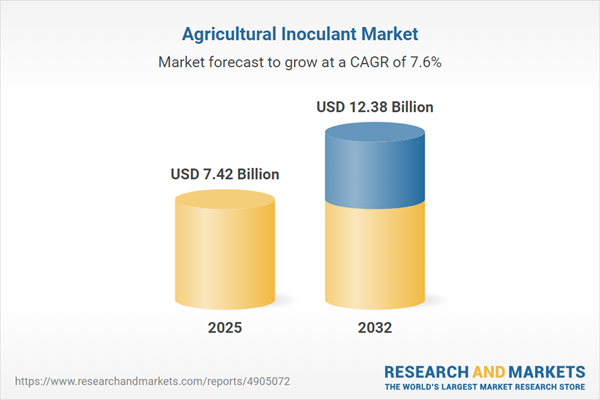Speak directly to the analyst to clarify any post sales queries you may have.
The agricultural inoculant market is advancing rapidly, with demand intensified by global sustainability imperatives and escalating interest in biological solutions for crop management. Senior leaders navigating agriculture and allied industries increasingly view agricultural inoculants as central for resilient, efficient food systems and yield optimization.
Market Snapshot: Agricultural Inoculant Market Growth and Outlook
The Agricultural Inoculant Market grew from USD 6.88 billion in 2024 to USD 7.42 billion in 2025. This market is set to sustain a compound annual growth rate of 7.61%, achieving USD 12.38 billion by 2032 as global adoption accelerates. Scientific innovation, evolving regulatory support, and the widespread necessity for sustainable agricultural inputs collectively drive expansion. This progression impacts both developed and emerging economies, stimulating investment and development across the sector.
Agricultural Inoculant Market: Scope & Segmentation
- Type: Includes key microbial options such as Azospirillum, Azotobacter, Frankia, and Rhizobium, plus fungi like Trichoderma and Mycorrhizae (Ectomycorrhizae, Endomycorrhizae), each delivering unique soil and crop benefits.
- Crop: Covers cereals and grains, fruits and vegetables, pulses and oilseeds, as well as turf and ornamentals, addressing a broad range of cultivation demands from staple producers to specialist growers.
- Formulation: Comprises granules, liquid suspensions, and powders, offering application flexibility and compatibility with varying farm-scale requirements and equipment.
- End Use: Encompasses both conventional and organic farming, reflecting industry-wide moves toward sustainable intensification and compliance with consumer trends.
- Application Method: Features foliar spray, seed treatment, and soil treatment, allowing producers to align input methods with efficiency and yield objectives.
- Sales Channel: Utilizes direct sales, distributor-based models, and online platforms to support global reach and improved access to market stakeholders.
- Americas: Active markets in the United States, Canada, Mexico, Brazil, Argentina, Chile, Colombia, and Peru benefit from regionally tailored solutions and robust distribution channels.
- Europe, Middle East & Africa: Presence in the United Kingdom, Germany, France, Russia, Italy, Spain, Netherlands, Sweden, Poland, Switzerland, United Arab Emirates, Saudi Arabia, Qatar, Turkey, Israel, South Africa, Nigeria, Egypt, and Kenya highlights the diversity in regulatory practices and agronomic conditions across these regions.
- Asia-Pacific: Addresses the dynamic needs of China, India, Japan, Australia, South Korea, Indonesia, Thailand, Malaysia, Singapore, and Taiwan, where rapid technology adoption and evolving food security priorities are shaping market strategies.
- Leading Companies: Competitive landscape features Novozymes A/S, BASF SE, Bayer AG, Chr. Hansen Holding A/S, Evonik Industries AG, Lesaffre S.A., Koppert Biological Systems B.V., Lallemand Inc., Rizobacter Argentina S.A., and Symborg S.L., all contributing significant R&D and supply capabilities.
Key Takeaways: Strategic Insights for Senior Decision-Makers
- Innovation in microbial efficacy and product targeting is broadening market appeal, supporting not only mainstream crop solutions but also niche farming needs.
- Digital agronomy is increasingly integrated with inoculant technologies, helping diverse farm operations refine input decisions and maximize productivity.
- Favorable policy environments and increased sustainability awareness are accelerating adoption, particularly where consistent frameworks support bio-based inputs.
- Regional soil health challenges and differentiated farming practices highlight the value of localized product customization and supply strategies.
- Synergies between agribusinesses, tech innovators, and research institutions continue to introduce new solutions and foster wider market entry.
- Supply chain diversification, including region-specific production and responsive logistics, helps address cost management and resilience to market or regulatory changes.
Impact of U.S. Tariffs on Supply Chains and Trade Flows
The recent application of U.S. import tariffs on critical inputs like carrier materials, packaging, and certain microbial strains has forced industry participants to reassess procurement and manufacturing approaches. Businesses are actively relocating or diversifying production facilities, forming new local alliances, and adopting lightweight formulations to limit additional expense. As a result, these strategic realignments foster more agile, resilient supply chains, enabling firms to better withstand trade disruptions and maintain market competitiveness.
Methodology & Data Sources
This report employs a mixed-methods research strategy, combining secondary materials—such as peer-reviewed journals, regulatory documents, and industry analyses—with direct primary interviews from key agricultural stakeholders worldwide. Rigorous data triangulation, value chain mapping, and SWOT analyses ensure robust, validated insights concerning sector trends and challenges.
Why This Report Matters
- Supports executive planning with detailed technology trends, evolving end-user requirements, and identification of accelerators and barriers to growth.
- Provides actionable insights on regional expansion opportunities, risk mitigation strategies, and targeted partnership models vital to the agricultural value chain.
- Equips senior teams to confidently prioritize resource allocation, portfolio expansion, and compliance readiness in an evolving regulatory landscape.
Conclusion
This analysis targets senior leaders seeking actionable intelligence within the agricultural inoculant market, emphasizing innovation, regulation, and partnership opportunities essential for holistic, sustainable sector growth.
Additional Product Information:
- Purchase of this report includes 1 year online access with quarterly updates.
- This report can be updated on request. Please contact our Customer Experience team using the Ask a Question widget on our website.
Table of Contents
3. Executive Summary
4. Market Overview
7. Cumulative Impact of Artificial Intelligence 2025
List of Figures
Samples

LOADING...
Companies Mentioned
The key companies profiled in this Agricultural Inoculant market report include:- Novozymes A/S
- BASF SE
- Bayer AG
- Chr. Hansen Holding A/S
- Evonik Industries AG
- Lesaffre S.A.
- Koppert Biological Systems B.V.
- Lallemand Inc.
- Rizobacter Argentina S.A.
- Symborg S.L.
Table Information
| Report Attribute | Details |
|---|---|
| No. of Pages | 187 |
| Published | October 2025 |
| Forecast Period | 2025 - 2032 |
| Estimated Market Value ( USD | $ 7.42 Billion |
| Forecasted Market Value ( USD | $ 12.38 Billion |
| Compound Annual Growth Rate | 7.6% |
| Regions Covered | Global |
| No. of Companies Mentioned | 11 |









